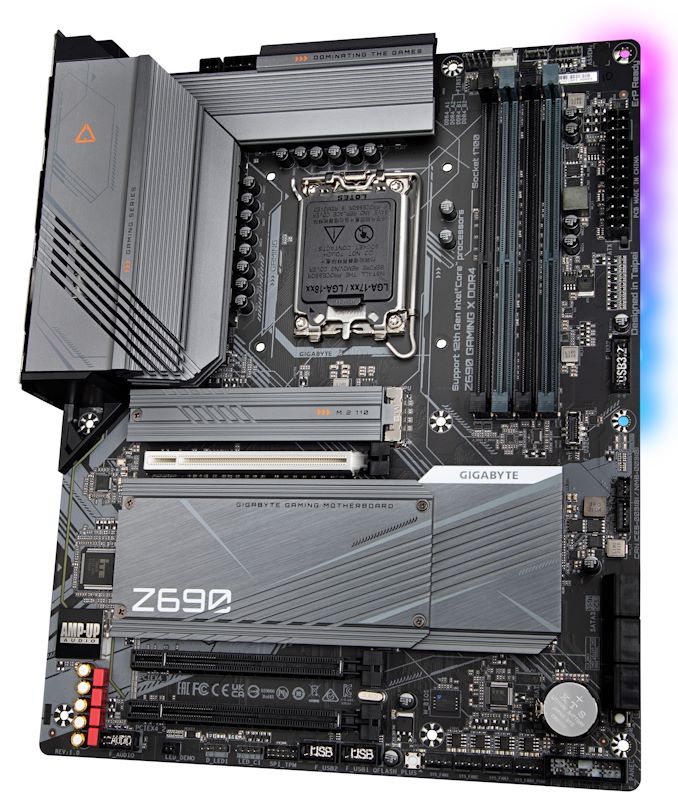The Intel Z690 Motherboard Overview (DDR5): Over 50+ New Models
by Gavin Bonshor on November 9, 2021 9:00 AM ESTGIGABYTE Z690 Gaming X (DDR5)
Out of all of GIGABYTE's gaming-centric Z690 options, the GIGABYTE Z690 Gaming X is perhaps the most basic from the brand in terms of features, but it looks very stylish for an 'entry-level' gaming model. From top to bottom, the GIGABYTE Z690 Gaming X is decked out in gunmetal grey, with a large power delivery heatsink, and plenty of M.2 heatsinks that amalgamate into the chipset heatsink; a very consistent design throughout. There's also a small element of integrated RGB LED lighting which can be found at the right-hand side of the board and provides a sort of an underglow effect.
Looking at connectivity, GIGABYTE includes one full-length PCIe 5.0 x16 slot, with two full-length PCIe 3.0 x4 slots. Located in and around the PCIe slot area is the board's M.2 storage, with GIGABYTE including four PCIe 4.0 x4 M.2 slots. There are also six SATA ports on the right-hand side with support for Intel RAID 0, 1, 5, and 10 arrays. Located in the top-right corner are the board's memory slots, with GIGABYTE opting for four in total with support for DDR5-6000 and support for up to 128 GB of capacity.
On the rear panel of the GIGABYTE Z690 Gaming X, there's one USB 3.2 G2x2 Type-C, two USB 3.2 G2 Type-A, three USB 3.2 G1 Type-A, and four USB 2.0 ports. The board omits Wi-Fi but does include an Intel I225-V 2.5 GbE controller which is the minimum specification on LAN we've seen on Z690 so far. Onboard audio options consist of two 3.5 mm audio jacks and S/PDIF optical output, with one HDMI and one DisplayPort video output pairing allowing users to leverage integrated graphics.












126 Comments
View All Comments
mode_13h - Friday, November 12, 2021 - link
I was really disappointed not to see more discussion of costs and why the price distribution of these boards tends to skew so high.However, I was most surprised to see how much lower some of the entry-level models are priced. Do we think these will be produced in sufficient volume, or are they primarily there as a means of upselling would-be buyers who, out of frustration at seeing them always out-of-stock eventually end up buying one of the more expensive models?
mikk - Saturday, November 13, 2021 - link
MSI Pro Z690-A WIFI, MSI Pro Z690-A and many more have the cheaper Realtek ALC897 Codec, the audio table is not accurate and it says Z490 instead of Z690.ajollylife - Sunday, November 14, 2021 - link
Wtf is with the PCIe 3.0 slots? I'm looking at the Gigabyte Aorus Master, has 10gig onboard, great, but then the other two pcie slots are pcie 3.0 So confused.mode_13h - Sunday, November 14, 2021 - link
From what I've read, PCIe 4.0 tends to require retimers, which adds cost and takes space. Those could be reasons why we don't see more PCIe 4.0 slots.back2future - Monday, November 15, 2021 - link
maybe mainboards start getting reshaped/redesigned (vertical m.2, backside slots/connectors, ?) instead of using retimers (chipset TDP includes retimer power?, cooling power for peripherals on PCIe 5.x speeds on 4GB/(s*lane)=~2 lanes sufficient for fastest available (2021, consumer) SSDs )?ecclesiastes121314 - Wednesday, February 23, 2022 - link
2 ram slots? I've seen this on a few of these new DDR5 boards. Most people here are talking about Thunderbolt 4 and USB4. Yes these are very useful to a select group of people yet these can be achieved with add on cards. Then you can pay for the devices to take advantage of these technologies. Reducing ram slots from 4 to 2. Wow. Yes you can buy high density ram. But this is forcing you that direction. What is wrong with 4x16 or 4x32 ram kits? If you (me) are interested in high performance video then affordable and available ram is a huge consideration. Is it just me?